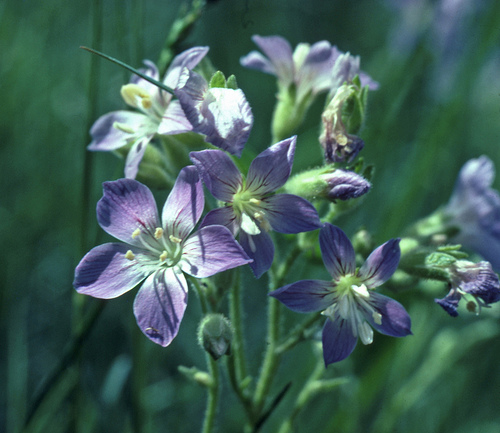One of the best ways to celebrate Mother Nature is to plant wildlife-friendly plants that are well adapted to your soil and climate. Native plants belong in every garden, and offer a number of benefits to consider.

Washington polemonium via Washington DNR/Flickr Creative Commons
What’s a native plant?
Basically, native plants are the plants that existed in a place without human introduction. So, not surprisingly, these native plants survive well without a lot of special care, because they are naturalized to grow in that area.
According to the Lady Bird Johnson Wildflower Center in Texas, “Native plants introduced into landscape plantings are hardy, less susceptible to pests and diseases and unlikely to escape and become invasive.”
These native plants also help us conserve water, reduce pesticides and decrease the need for fertilizers. Often, if you grow the right plants for your area, you won’t even need to amend the soil much, if at all.

Woodland sunflower via Kristine Paulus/Flickr Creative Commons
Supporting nature
Less work is certainly a big plus with growing native plants in the garden. But that’s not all.
These native plants also provide a valuable ecosystem for pollinators and wildlife. That’s particularly important, because native plant communities are disappearing rapidly due to spreading housing developments and agribusinesses. By growing native plants in our gardens, we help provide much-needed food sources and homes for birds, butterflies and other beneficial critters.
Something for every garden
Fortunately, there is such a wild variety of native plants that there is something for every garden style. Often it’s just a matter of pruning these plants as you would an ornamental plant. There’s no reason these plants can’t be as attractive as the other flowers, bushes and trees in your garden.
- Imagine some bluebonnets (Lupinus texensis) growing in a pretty perennial bed with well-drained soil, or cheerful yellow arrowleaf balsamroot (Balsamorhiza sagittata) blooming from April to June on that dry hill out back.
- Purple coneflower (Echinacea sp.) can already be found in many gardens, as can yarrow (Achillea millefolium), which looks pretty when blooming in summer, as well as when the flowers dry on the stem late in the season.

American beautyberrty via UGArdener/Flickr Creative Commons
- Don’t forget about native grasses, such as ‘Hachita’ blue grama grass (Bouteloua gracilis ‘Hachita’), which only grows about 15 inches tall. There are also native shrubs such as American beautyberry (Callicarpa americana), shown above.
- Native trees are available for every climate too, from aspens (Populus tremuloides) in the north, to eastern red cedars (Juniperus virginiana), the most widely distributed conifers in the east.
As you start planting this garden season, take a look at the natives. With their good looks, easy-care maintenance and eco-friendly attributes, native plants really do belong in every garden.
Tip: Search the Native Plant Database on the Lady Bird Johnson Wildflower Center website to find which native plants will thrive in your garden.

Share tips, start a discussion or ask one of our experts or other students a question.
No Responses to “Why You Should Be Growing Native Plants in Your Garden”